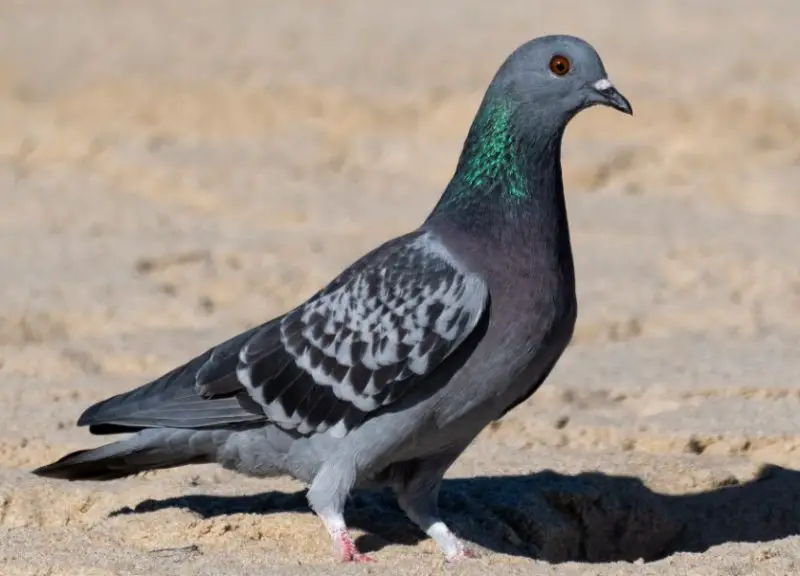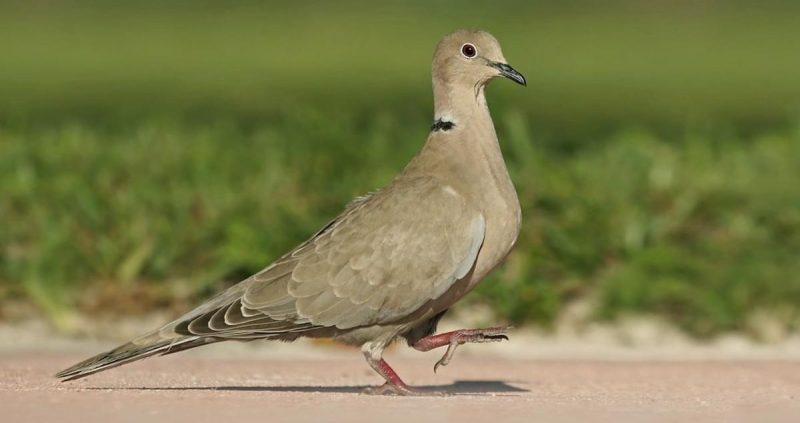Hawaii’s warm climate and diverse habitats make it home to several beautiful dove species. Whether wandering city streets or exploring lush gardens, these gentle birds add charm and life to the islands.
During my visits across the islands, I’ve often spotted doves quietly feeding on seeds or cooing softly from tree branches. Their distinctive calls and graceful movements make them easy to appreciate for bird lovers and casual observers alike.
In this guide, you’ll learn about six common types of doves found in Hawaii. Each species includes clear identification tips, interesting behaviors, and vibrant pictures to help you spot them with confidence.
Common Doves Found in Hawaii
Zebra Dove (Geopelia striata)

The Zebra Dove is a small, slender bird known for its distinctive barred pattern on the neck and chest, which resembles zebra stripes. Its overall color is a mix of soft browns and grays with a bluish-gray face and pinkish underparts. The long, tapered tail and delicate build make it quite elegant in appearance. This dove typically measures about 20 to 23 cm (8 to 9 inches) in length, making it one of the smaller doves commonly seen in Hawaii.
Zebra Doves produce a soft, pleasant cooing sound that is often described as a series of gentle, repetitive “coo-coo” notes, creating a calming and melodic background in many Hawaiian neighborhoods. They are known for their calm and friendly nature, often seen walking on the ground in search of small seeds and insects. Unlike many doves, Zebra Doves tend to be quite social, frequently gathering in small groups, especially near human habitation.
Breeding for Zebra Doves can occur year-round in Hawaii, with pairs building simple nests in shrubs, trees, or even on man-made structures. Their nests are often flimsy platforms of twigs and grasses, usually placed low to the ground. Clutch size generally consists of two white eggs, which both parents incubate for about 13 to 15 days. The chicks are altricial, meaning they hatch helpless and depend heavily on their parents.
Zebra Doves were introduced to Hawaii and have adapted well to the island environment, thriving in urban, suburban, and rural areas. They prefer open spaces with scattered shrubs and trees but are very common in parks, gardens, and around homes. A fun fact about Zebra Doves is that their calm and gentle calls have earned them the nickname “Barred Ground Dove,” and in Hawaiian culture, their presence often symbolizes peace and harmony.
Mourning Dove (Zenaida macroura)

Mourning Doves are medium-sized birds with a slender, streamlined body and long, pointed tails that often show white edges in flight. Their plumage is generally light brown to buff with subtle black spots on the wings and a slight pinkish hue on the breast. They measure around 28 to 34 cm (11 to 13.5 inches) long, making them larger than Zebra Doves but still graceful. Their soft, mournful cooing call—hence the name—is a familiar and soothing sound in many parts of Hawaii.
The signature call of the Mourning Dove is a slow, rhythmic “cooo-OO-oo,” which can carry over long distances. These birds are known for their swift and direct flight, often flying low with rapid wing beats. They primarily feed on seeds and grains found on the ground, occasionally supplementing their diet with small insects. Mourning Doves are generally monogamous and form strong pair bonds during the breeding season.
Mourning Doves breed multiple times per year in Hawaii. They build rather flimsy nests, usually in trees, shrubs, or sometimes on ledges and human structures. The female typically lays two white eggs, which both parents incubate for about 14 days. The young fledge roughly two weeks after hatching. Mourning Doves are also known for their “crop milk” — a nutrient-rich secretion produced by both parents to feed their chicks.
In Hawaii, Mourning Doves are found across many islands, especially in open and semi-open habitats such as fields, parks, and residential areas. They have adapted well to human-altered landscapes. A fun fact: Mourning Doves are one of the most widespread and abundant bird species in North America, and their migration patterns sometimes bring them to Hawaii as occasional visitors or residents.
Spotted Dove (Spilopelia chinensis)

The Spotted Dove is easily recognized by the distinctive black-and-white spotted patch on the sides of its neck, giving it its name. Its plumage is generally soft brown with a slight pinkish tint on the chest and belly. The body is moderately plump with a long tail that tapers to a rounded tip. Adult Spotted Doves measure about 28 to 30 cm (11 to 12 inches) in length, similar in size to Mourning Doves but more robust in build.
Their call is a series of soft, melodious coos often transcribed as “who-cooks-for-you, who-cooks-for-you-all,” which is a common sound in gardens and parks across Hawaii. Spotted Doves are typically ground feeders, searching for seeds and small invertebrates. They are fairly shy but become accustomed to human presence, especially in urban and suburban areas, where they can be frequently spotted resting on fences or perching on low branches.
In Hawaii, Spotted Doves breed year-round, building simple nests of twigs usually placed in trees or shrubs. They generally lay two eggs per clutch, which both parents incubate for about 13 to 15 days. Their chicks remain in the nest for roughly two weeks before fledging. Spotted Doves are quite adaptable and often coexist peacefully with other dove species and birds in their habitats.
These doves have been introduced to Hawaii but have successfully established populations on several islands. They thrive in a variety of environments, from city parks to farmland and coastal scrub. A fun fact about the Spotted Dove is that despite its name, the spots on its neck resemble a lace collar, giving it an elegant, almost regal appearance that makes it popular among bird watchers.
Rock Pigeon (Columba livia)

The Rock Pigeon, often known simply as the city pigeon, is a medium-sized bird with a stout body and short neck. Its plumage varies widely but typically features shades of gray with iridescent green and purple feathers around the neck and chest. Rock Pigeons measure approximately 30 to 35 cm (12 to 14 inches) in length, making them larger and bulkier than most other doves in Hawaii. Their short legs and rounded tail are characteristic features.
These pigeons produce a soft cooing sound that is rhythmic and repetitive, often described as “coo-roo-coo.” They are well adapted to urban environments, frequently seen in cities, parks, and coastal areas where they scavenge for food. Their behavior includes strong flocking instincts, and they are known for their remarkable homing ability, which has been utilized for centuries in pigeon racing and messaging.
Rock Pigeons breed year-round in Hawaii, constructing nests on building ledges, cliffs, bridges, or other structures that mimic their natural rocky cliff habitats. Nests are simple platforms made from twigs and debris, and females typically lay two white eggs per clutch. Both parents share incubation duties, and chicks, called squabs, are fed “crop milk” before fledging in about four weeks.
In Hawaii, Rock Pigeons are common across all the main islands, thriving especially in urban and coastal areas. A fun fact about Rock Pigeons is that they were the first birds ever domesticated by humans and have been companions, messengers, and racers for thousands of years worldwide.
White-winged Dove (Zenaida asiatica)

The White-winged Dove is a striking medium-sized dove known for the prominent white stripe on its wings, visible in flight. Its body is mostly gray-brown with a slightly darker head and a pale belly. This dove measures around 26 to 31 cm (10 to 12 inches) in length, similar in size to the Mourning Dove. Its eyes are surrounded by a distinctive blue ring, adding to its unique appearance.
White-winged Doves produce a loud, hooting call, often described as a rolling “who-cooks-for-you” sound, which echoes across their desert and woodland habitats. They are mostly ground feeders, eating seeds, grains, and fruits, and have adapted to a variety of environments. In Hawaii, they are considered rare visitors rather than established residents, with occasional sightings reported on some islands.
Breeding behavior of White-winged Doves involves building flimsy stick nests, usually in trees or shrubs. They lay two eggs per clutch, which are incubated by both parents for about two weeks. The young doves remain in the nest for approximately 13 to 15 days before fledging. These birds are known for their monogamous pair bonds and diligent parental care.
Though not common in Hawaii, White-winged Doves have been recorded sporadically, likely due to occasional dispersal from nearby regions or escape from captivity. A fun fact is that in some parts of their native range, White-winged Doves are culturally significant and were once a popular game bird in the southwestern United States and Mexico.
Eurasian Collared-Dove (Streptopelia decaocto)

The Eurasian Collared-Dove is a medium-sized dove with pale gray to beige plumage and a distinctive black collar around the back of its neck. This species measures about 32 cm (12.5 inches) in length, making it one of the larger doves in Hawaii. Its body shape is slender, with broad wings and a squared tail that often shows white tips when in flight.
This dove is known for its loud, repetitive cooing call, often described as “coo-COO-coo, coo, coo.” It has a curious and adaptable nature, quickly becoming accustomed to urban and suburban environments. Eurasian Collared-Doves primarily feed on seeds and grains found on the ground and are often observed foraging near human settlements.
Eurasian Collared-Doves breed year-round in suitable climates, building flimsy nests of sticks in trees, shrubs, or on buildings. Females usually lay two white eggs per clutch, with both parents participating in incubation. The young fledge about two weeks after hatching. This species is known for its rapid population expansion, having spread widely across North America and beyond within just a few decades.
In Hawaii, the Eurasian Collared-Dove is considered an introduced species and is gradually establishing populations on several islands. A fun fact about this dove is its incredible colonizing ability: it has expanded its range from Europe and Asia to much of the world in just over a century, demonstrating remarkable adaptability.
Frequently Asked Questions About Doves in Hawaii
What types of doves can be found in Hawaii?
Hawaii hosts several dove species, including the Zebra Dove, Mourning Dove, Spotted Dove, Rock Pigeon (often considered a type of dove), White-winged Dove, and Eurasian Collared-Dove. Some are native, while others have been introduced.
Are doves common in urban areas of Hawaii?
Yes, many dove species like the Zebra Dove, Rock Pigeon, and Eurasian Collared-Dove thrive in urban and suburban environments, often seen in parks, gardens, and around homes.
What do doves in Hawaii eat?
Doves primarily feed on seeds, grains, and small insects. Many species forage on the ground, searching for fallen seeds, while some may also consume small fruits.
How can I identify a Zebra Dove?
Zebra Doves are small, slender birds with distinctive black-and-white barred patterns across their chest and neck, resembling zebra stripes. They have a soft cooing call and a gentle temperament.
Do doves breed year-round in Hawaii?
Most dove species in Hawaii can breed throughout the year due to the stable tropical climate. They typically build simple twig nests and lay two eggs per clutch.
Are any doves in Hawaii considered invasive?
Yes, species like the Spotted Dove and Eurasian Collared-Dove were introduced to Hawaii and are considered invasive as they compete with native birds for resources.
Can I attract doves to my garden in Hawaii?
You can attract doves by providing open areas with seed-bearing plants and shallow water sources. Avoid using pesticides to ensure they have access to insects for protein.
Do doves make good pets?
While some doves can be kept as pets, wild doves in Hawaii are best appreciated in their natural habitat. Keeping native or wild birds as pets may be regulated or prohibited.
What is unique about the White-winged Dove in Hawaii?
The White-winged Dove is a rare visitor to Hawaii and is known for its striking white wing patches visible in flight and its distinctive hooting call.
How do doves contribute to Hawaiian ecosystems?
Doves play a role in seed dispersal and serve as prey for native predators. They also add to the biodiversity and aesthetic beauty of Hawaii’s natural and urban landscapes.






